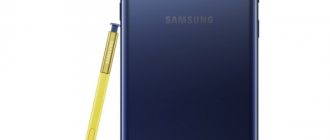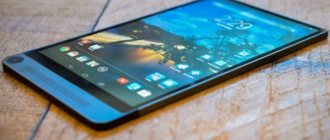Samsung Galaxy S20
Samsung, as a manufacturer of Amoled matrices, occupies a larger share of the market for OLED matrices for smartphones, puts only the best on its flagships, and this is logical, since such an approach increases the competitiveness of its own phones in the market. The next flagship again becomes the best in terms of screen – the Galaxy S20 received a matrix with QHD+ resolution, which can operate with a refresh rate of 120 Hz, however, with FHD+ resolution. In this mode, scrolling becomes smoother, and using the phone becomes more enjoyable.
Of course, maximum contrast and minimum color rendering errors are included, and under the screen there is an ultrasonic fingerprint scanner, which works faster and more accurately than an optical one.
Powerful hardware, water protection, a cool camera with OIS and flagship technologies like reverse charging are included, so the Samsung S20 is the best on the market today, including in terms of screen. Find out more in the Samsung Galaxy S20 review
Google Pixel 4
The flagship from Google, which costs much less than the Samsung S20. It offers a 5.7-inch OLED display, that is, it is not a “shovel”, which we definitely write down as an advantage. The screen here is notable primarily for its 90 Hz refresh rate, and secondly for its maximum contrast. Of course, it plays HDR content, although you're unlikely to find high-quality HDR video anywhere.
Plus, the Pixel 4 is equipped with a great camera and even smarter software for it, capable of adjusting the exposure even before the shot is taken. Let's add here protection from water, a telephoto camera with 2x zoom, stereo speakers and a powerful 7nm Snapdragon 855 processor. Plus, there is a feature - a sensor on the front that reacts to the owner's gestures, which allows you to scroll through tracks, for example, with a hand gesture in the air without touching your smartphone.
The disadvantage is low battery life: only 9:35 hours of web surfing or 11:16 hours of video playback. If your priority is not only a good screen, but also high battery life, then it’s better not to buy the Pixel 4A. Find out more in our Google Pixel 4 review
OnePlus 7T Pro
Another cool flagship from BBK is the OnePlus 7T Pro with an OLED screen with a 90Hz refresh rate. OnePlus 8 and OnePlus 8 Pro have already been released with more advanced matrices, but they are not on sale yet, so the OnePlus 7T Pro or the regular 7 Pro (without T) comes in third place.
Maximum contrast, HDR10+, accurate color reproduction, and an under-screen fingerprint scanner included. Plus, it has a powerful processor, a cool 48 MP camera with OIS and a large 4085 mAh battery and even stereo speakers, but there is a suspicion that this flagship costs more than it should. Find out more in the OnePlus 7T Pro review.
Smartphone matrix type
The technologies presented for comparison took their origins from their predecessors:
- TN+film
- AMOLED
The first took liquid crystals as a basis, and the second used silicon crystals. Currently, IPS is considered not a separate technology, but a modification of TN+film. But in what ways have the products developed? This question should be answered to track the full package of innovations in IPS technology in order to compare it with LTPS.
Innovation : Thin film transistors (TFTs) were used for the first time in IPS. They are necessary to illuminate subpixels - micro-inclusions located around the circumference of the main pixel. Subpixel backlighting allows you to create a backlight gradient for the main pixel, which multiplies color rendition and image clarity.
The same technology is used in LTPS, but more compactly, since the backlight is provided not by the backlight matrix, but by working with each pixel individually.
Xiaomi Mi 9T
An inexpensive phone from Xiaomi with a cool OLED screen with HDR and maximum contrast. This is likely the cheapest phone on the market with similar display specs.
Moreover, this is far from the only advantage of the device. It also has a powerful mid-range Snapdragon 730 processor, a good Sony IMX 582 camera, telephoto and wide-angle cameras. Inside there is a 4000 mAh battery + 18 W fast charging, there is NFC and an under-screen fingerprint scanner. Test results and photo examples are in the Xiaomi Mi 9T review.
Samsung Galaxy A71
Front view.
Source - GSMArena An average smartphone from the Korean brand Samsung, which also offers a cool Amoled screen, although without HDR10 support. But even without this, the quality of the screen is at the highest level: firstly, there is infinite contrast (that is, there is no light on black tones); secondly, the screen brightness is high – 515 cd/m2, color rendering error is low – DeltaE 1.7, which is cool.
Let's add a powerful Snapdragon 730 processor, a large 4500 mAh battery, fast charging, NFC and a cool 64 MP camera and we get a gorgeous phone with one of the best screens in the world, albeit without HDR.
Production technologies
The next thing worth talking about is the technologies that are used in the production of phone screens. Mainly LCD, OLED, AMOLED.
LCD
LCD or liquid crystal displays are one of the most widely used panel types in the world. This is a technology that replaced earlier solutions such as CRT (cathode ray tube), which was used in bulky computer monitors in the 90s of the last century.
LCD displays are divided into several types, including IPS (in-plane switching) and LED-backlit panels. However, these days, most smartphones come with IPS LCD displays. Why? Because they are more affordable and generally more durable than AMOLED.
If we talk about the quality of picture display, it should be noted that LCD displays are characterized by quality and color accuracy. However, if you are a person who likes rich and bright pictures, then the LCD display may disappoint you a little.
One of the main advantages of IPS LCD displays is their lower power consumption. Therefore, if you are a heavy user, you should probably choose a smartphone with an LCD panel. However, even though an LCD display consumes less power, overall it will depend on several factors such as usage and battery capacity of the smartphone.
Advantages:
- Lower power consumption.
- Rendering natural colors.
- Relatively cheap.
- Gives good viewing angles.
Flaws:
- Relatively lower brightness.
- Less black depth.
OLED
The abbreviation OLED stands for “Organic Light-Emitting Diode”. OLED displays produce richer, more natural colors.
The technology is based on the illumination of individual pixels, which is expressed in the use of organic materials to create them, emitting light when current passes through them. Each pixel of an OLED display has its own color. Therefore, OLED displays have higher brightness than LCD panels.
OLED displays provide deeper blacks and whites. They are flexible, compact and thin. Therefore, they are now also installed in high-end TVs.
Due to their ability to produce deep, dark colors, OLED displays typically consume more power and are therefore more expensive than LCD displays.
OLED displays are more unstable than LCD or AMOLED. In addition, they suffer more from exposure to water. Smartphones that have an OLED panel tend to be more expensive than smartphones with LCD and AMOLED displays.
Advantages:
- Excellent color rendition thanks to the use of pixel backlighting.
- The ability to create flexible and thin smartphones.
- Overall great brightness.
Flaws:
- Less reliability.
- Higher power consumption.
AMOLED
The abbreviation AMOLED stands for “Active Matrix Organic Light Emitting Diode” (or “Active Matrix Organic Light Emitting Diode”). And don’t let the reader be scared by such an abstruse name - the description below will help you understand how AMOLED displays work and how they differ from LCD and OLED panels.
And they work on the basis of an active matrix system, which provides and controls the glow of each pixel through the use of thin film transistors (TFT).
Compared to LCD and OLED displays, AMOLED screens are capable of producing richer, more vibrant colors. In addition, they are lighter and more flexible.
AMOLED technology has found its application in both the smallest and largest devices, such as tablets, game consoles, smart watches, etc.
The color reproduction of AMOLED displays is simply superb and they tend to be a little brighter than OLED displays. It is also the most expensive smartphone technology when compared to LCD and OLED.
And this is one of the many reasons why AMOLED smartphones are more expensive.
Advantages:
- Provides the transmission of bright and rich colors.
- Average electricity consumption.
- Greater flexibility compared to LCD and OLED.
Flaws:
- Viewing angles are low.
- They cost more than OLED and LCD.
The best IPS screens
- Redmi Note 8 Pro is an excellent option with an IPS matrix and HDR support. No other phone under 15 thousand rubles offers HDR, but the downside is that the color rendering error here is high (white color fades into cool tones).
- Realme 5 Pro is one of the best mid-rangers with an IPS screen with a brightness of 512 cd/m2 and a contrast ratio of 1875:1, which is very cool. Moreover, the color rendering error here is low – DeltaE 3.7.
- Redmi Note 8T is a high-quality budget phone up to 12 thousand rubles with a 6.3-inch diagonal IPS matrix and Full HD+ resolution. It offers a brightness of 600 cd/m2 on whites and 0.45 cd/m2 on blacks, giving a high contrast ratio of 1325:1. Great camera, big battery and power efficient processor included.
- Oppo A9 (2020) and Realme 5 are smartphones with HD screens, that is, with low pixel density. And such IPS matrices are in some sense the best due to low battery consumption, plus they are less demanding on the processor. Moreover, modern IPS screens, even with HD resolution, produce high-quality, detailed images without pixelation. Moreover, both of these smartphones offer large 5000 mAh batteries and provide the highest autonomy.
Please rate the article:
Join on Telegram
Comparing IPS and LTPS technologies
IPS is a method for producing matrices for liquid crystal monitors and displays, which includes four structural elements.
- Illumination matrix or lamp. Its function is to illuminate the display from the inside.
- Pixel and light filtering systems.
- Liquid based crystals.
- Microelectrodes over the entire surface of the matrix.
Innovation : Unlike the old TN - IPS has a 170-degree view.
LTPS - in turn, this technology is based on the use of crystalline silicon, which is capable of producing an induction current at low temperatures.
The size of the silicon crystal is no more than 0.1 microns. In order to obtain crystals of this size and quality, silicon is deposited with gas, and then fired at a plasma temperature of up to 1000 degrees Celsius.
A characteristic innovation is the use of a small amount of energy with the rapid transfer of electrons, but at the same time the system response is slower when pressing on the interactive display. Ping length – 0.15 s.











